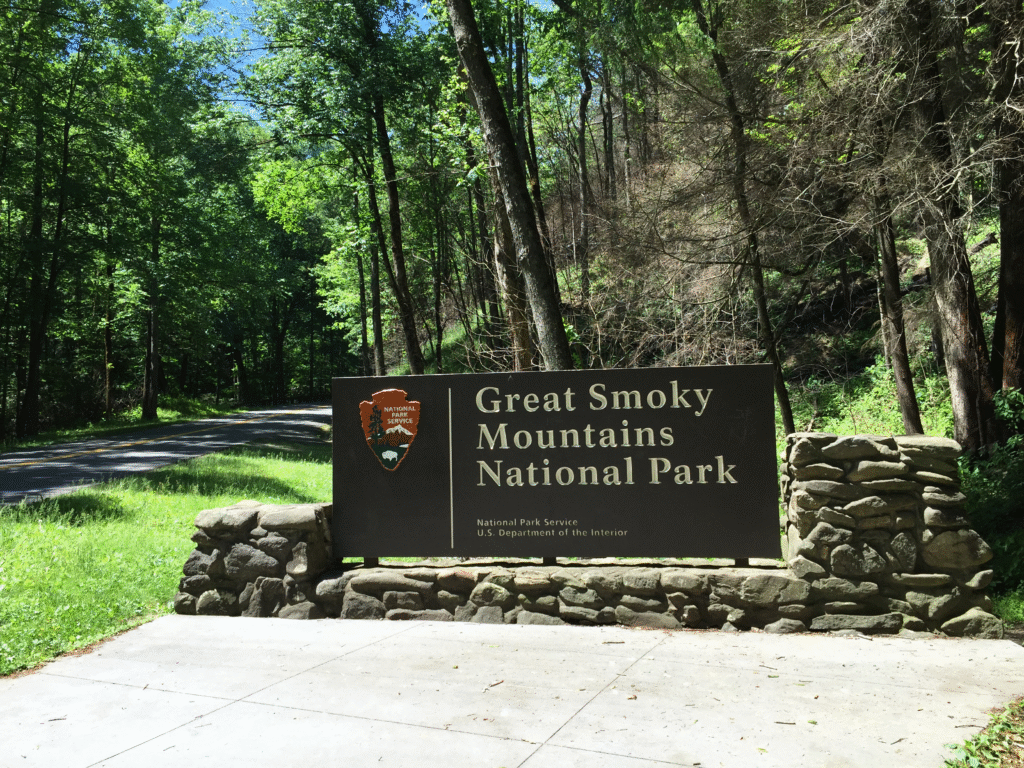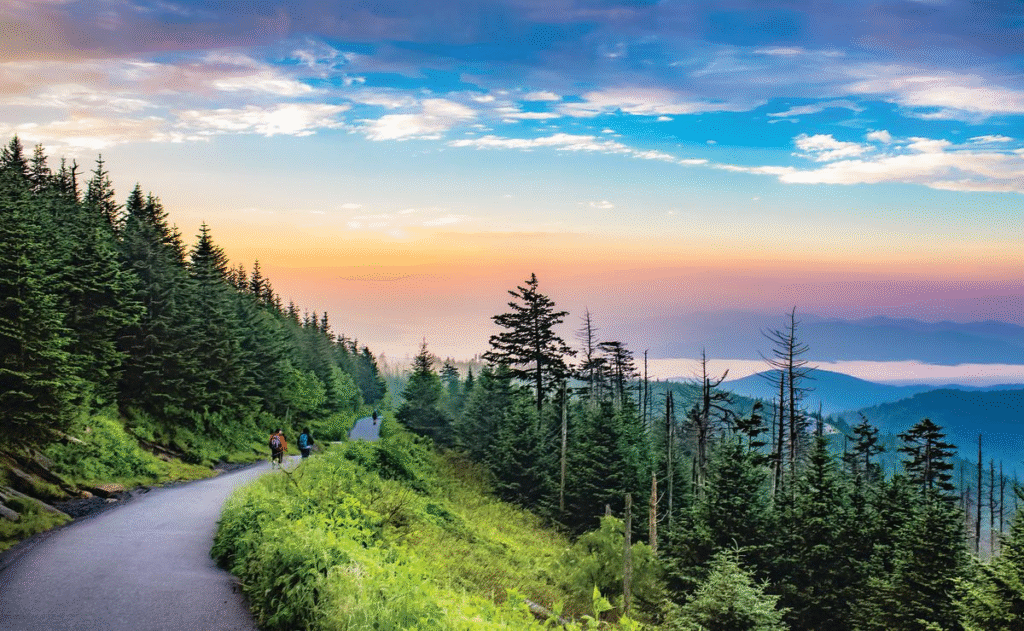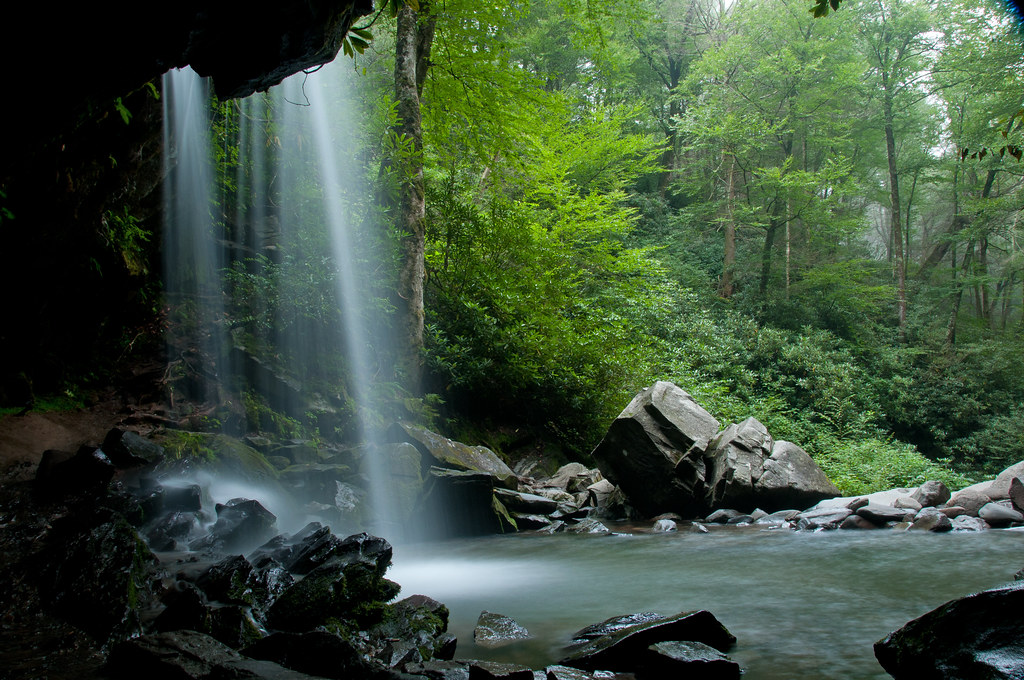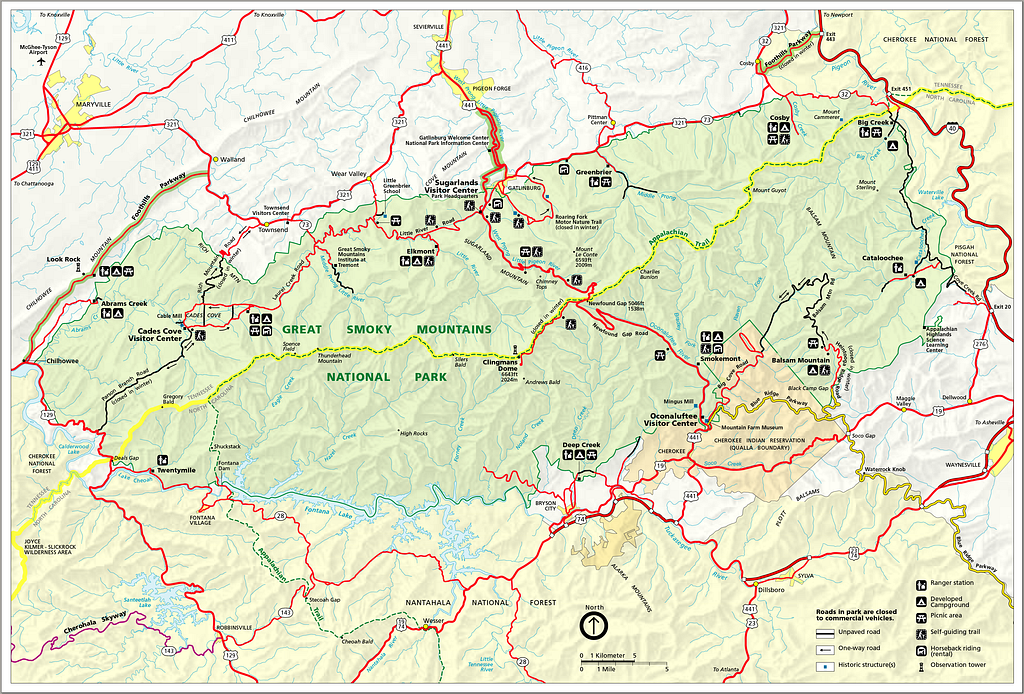
Picture this: sunlight filtering through a canopy of ancient trees, your boots crunching on paths worn by centuries of wanderers. That’s the magic waiting in the Great Smoky Mountains—a place where every turn reveals something wild, something sacred. I’ve walked these routes countless times, yet they still surprise me. Moss-covered stones whisper stories of Cherokee hunters and pioneer settlers. Crisp mountain air carries the scent of pine and distant campfires.
This mountain’s national park isn’t just about scenery. It’s a living museum. You’ll find quiet streams perfect for reflection and ridges that dare you to climb higher. Some routes wind gently through valleys—ideal for families or a peaceful afternoon. Others, like the legendary Appalachian Trail segment here, test your grit with steep ascents and rocky outcrops.
What thrills me most? The hidden corners. A waterfall tucked behind a bend. A meadow bursting with fireflies at dusk. The Smoky Mountains National Park balances grandeur with intimacy, offering adventures that feel both epic and deeply personal. Seasons transform the landscape constantly—autumn’s fiery palette, winter’s silent frost, spring’s wildflower explosions.
Contents
- 1 Unveiling the Best Smokies Hiking Trails
- 2 Top Must-See Trails in the Great Smoky Mountains
- 3 Trail Safety and Current Conditions
- 4 Exploring Nature’s Features: Waterfalls, Forests, and Views
- 5 Planning Your Hiking Trip: Maps, Permits, and Tips
- 6 Family-Friendly and Kid-Approved Hikes
- 7 Dog-Friendly Paths and Pet Travel Tips
- 8 Immersing in History and Local Culture
- 9 Insider Recommendations and Seasonal Highlights
- 10 Conclusion
- 11 FAQ
- 11.1 What’s the best way to prepare for elevation changes on longer routes?
- 11.2 Are there hidden gems beyond the popular waterfalls?
- 11.3 Can I bring my dog to high-elevation viewpoints?
- 11.4 How early should I arrive to secure parking at trailheads?
- 11.5 What makes fall the ideal season for panoramic vistas?
- 11.6 Are backcountry permits required for overnight stays?
- 11.7 How do I navigate stream crossings safely after rain?
Key Takeaways
- Discover trails ranging from easy walks to challenging backcountry routes
- Experience rich history through ancient paths and cultural landmarks
- Witness diverse ecosystems and seasonal transformations
- Find secluded natural wonders beyond popular viewpoints
- Prepare for varying terrain and weather conditions
Unveiling the Best Smokies Hiking Trails
Every step here feels like a conversation with the earth—each route a story waiting to be lived. I’ve traced these ancient pathways through mist-cloaked mornings and golden afternoons, discovering why certain journeys become legends. Three routes rise above the rest, not just for their views, but for how they stir the soul.
Highlights of Top Routes
Chimney Tops challenges you with its quartzite pinnacles—a steep climb rewarded with 360-degree panoramas. Alum Cave Bluffs dazzles with concave cliffs and trickling springs, while Andrews Bald blooms with flame azaleas each June. These aren’t mere walks; they’re full-body experiences where fog clings to your skin and granite hums beneath your palms.
Why These Journeys Captivate
What makes these paths unforgettable? It’s the way sunlight slices through Alum Cave’s arch at midday, painting rainbows in the spray. Or how winter transforms Andrews Bald into a snow-dusted chessboard, silent except for the crunch underfoot. The Great Smoky Mountains National Park doesn’t just showcase nature—it stages dramas where fireflies choreograph summer nights and autumn sets the ridges ablaze.
- Chimney Tops: A test of endurance with geological marvels
- Alum Cave: A walk through living rock formations
- Andrews Bald: Seasonal wildflower spectacles
These routes aren’t checkboxes on a map. They’re invitations to witness centuries-old forests breathing, to stand where Cherokee scouts once scanned the horizon. Come fall, the maples burn so bright you’ll swear the mountains themselves are aflame. In spring, trilliums carpet the earth like fallen stars. This is where great smoky vistas become personal epics.
Top Must-See Trails in the Great Smoky Mountains

You know that moment when sunlight catches mist rising from a valley, and the world feels both vast and intimately yours? That’s the pulse of these mountains’ national treasures—routes where earth and sky conspire to leave you breathless. Let me guide you through three paths where every switchback reveals poetry.
Chimney Tops and Andrews Bald
The 3.8-mile Chimney Tops climb feels like scaling nature’s cathedral. Quartzite steps demand grit—1,487 feet of elevation gain—but the payoff? A rocky spire where clouds dance at eye level. Time it right, and sunset turns the horizon into liquid gold.
Andrews Bald offers softer magic. At 5,920 feet, this grassy plateau blooms with rhododendrons in June. The 3.6-mile round trip feels like walking through a living watercolor—soft greens, sudden bursts of fuchsia. Bring a picnic; the fog rolls in like whispered secrets.
Alum Cave Bluffs and Scenic Overlooks
Alum Cave isn’t a cave at all. It’s a concave cliff face where mineral streaks paint the rock silver and rust. The 4.4-mile trek gains 1,125 feet, each turn revealing something new—Arch Rock’s mossy tunnel, log bridges over singing streams. Reach the bluffs by midday, and sunlight fractures through mist into rainbows.
What stays with you? The way your breath syncs with the climb. How lichen glows neon after rain. These mountain national routes aren’t just walks—they’re love letters to persistence, signed with blistered heels and widened eyes.
- Chimney Tops: 3.8 miles round trip, strenuous
- Andrews Bald: 3.6 miles, moderate with wildflower meadows
- Alum Cave Bluffs: 4.4 miles, geological wonders at every turn
Trail Safety and Current Conditions
The mountains whisper secrets to those who listen—but they demand respect in return. I’ve learned this through fogged-up glasses on rain-slicked rocks and sudden summer storms that rewrite itineraries. Conditions here shift like the wind—one moment all sunlit promise, the next a test of resolve.
Seasonal Challenges and Weather Considerations
Spring’s thaw transforms quiet streams into roaring obstacles. Last April, I watched a 5-mile route double in difficulty as footbridges vanished under chocolate-colored currents. Summer brings its own tricks—humidity thick enough to drink, thunderstorms that explode like shaken soda cans. Come October, frost greets dawn hikers on ridges, while winter’s silence hides black ice beneath powder.
| Season | Challenge | Critical Gear |
|---|---|---|
| Spring | Swollen streams, mudslides | Waterproof gaiters, satellite communicator |
| Summer | Heat exhaustion, lightning | UV-protection clothing, storm shelter |
| Fall | Sudden temperature drops | Layered insulation, emergency blanket |
| Winter | Limited visibility, avalanche risk | Snowshoes, avalanche transceiver |
Essential Safety Tips for Hikers
Never let mileage numbers fool you. A 3-mile trail in July heat drains faster than a 7-mile trek in crisp autumn air. Check the park’s trail condition alerts religiously—downed trees from last week’s windstorm could block your path tomorrow. Start at sunrise to outrun afternoon storms, and pack like you’re preparing for three weather eras at once.
Your gear choices write the story’s ending. I’ve seen water filters save dehydrated groups and headlamps turn panic into purpose when dusk arrived early. Remember: these paths reward preparation as much as courage. Walk softly, listen closely, and let the land’s wild heartbeat guide you home.
Exploring Nature’s Features: Waterfalls, Forests, and Views
There’s a particular alchemy here—water shaping stone, light rewriting landscapes—that turns ordinary walks into revelations. I’ve watched dawn break over cascades that look like liquid lace, their mists catching rainbows in midair. These moments don’t just dazzle; they rewrite your understanding of wild beauty.
Waterfalls and Stream Crossings
Crossing Laurel Creek last spring, I learned how streams become collaborators. My boots sank into silt as cold water swirled around my ankles—a baptism into the park’s rhythm. Waterfalls here aren’t mere photo ops. They’re living sculptures where hemlock roots grip sandstone like arthritic fingers, and moss glows neon after rain.
Remember the hidden cascade near Abrams Creek? Reaching it requires balancing on slippery stones while ferns brush your shoulders. Worth every shaky step. The roar builds gradually—a bass note vibrating in your chest—until you round the bend and see whitewater plunging into an emerald pool.
Unforgettable Panoramic Vistas

I’ll never forget my first sunrise at Clingmans Dome. Fog pooled in valleys like spilled milk, while ridges emerged like islands in a silver sea. That’s the park’s genius: perspectives shift with every cloud, every slant of light. You don’t just see views here—you feel them in your diaphragm.
Plan your trip to hit these overlooks at golden hour. Charlie’s Bunion transforms into a chiaroscuro masterpiece, shadows carving depth into ancient rock. Bring binoculars. Distant hawks riding thermals become brushstrokes in a living painting.
Pro tip: Use the park’s official map to thread waterfalls and vistas into one epic day. Start early—mist clings to falls until midmorning, creating ethereal photo conditions. Pack a waterproof notebook. You’ll want to sketch what cameras can’t capture: the way sunlight fractures through spray, or the exact green of new maple leaves backlit by afternoon sun.
Planning Your Hiking Trip: Maps, Permits, and Tips
Maps unfurl like whispered promises here—each contour line a secret handshake with the land. I’ve learned that preparation isn’t just practical; it’s poetry. Your adventure begins long before lacing boots, in the dance between digital tools and paper charts, revealing the trails the Smoky Mountains hide best.
The park’s app becomes your compass. I layer its offline maps with GAIA GPS—watch blue dots trace your progress through rhododendron tunnels. Pro tip: bookmark ranger-approved routes on AllTrails. Filter by elevation gain or waterfall proximity. Last fall, this combo led me to a hidden overlook where fireflies outnumbered stars.
Permits Made Painless
Backcountry stays demand permits—snag them early. The National Park Service portal opens slots four months ahead. I set calendar alerts for popular seasons. Pro move? Target midweek dates when competition thins. Remember: some trails smoky with autumn crowds require additional shuttle reservations. Check the park’s Twitter for real-time alerts on closures.
| Permit Type | When to Apply | Key Details |
|---|---|---|
| Backcountry | 4 months pre-trip | Max group size: 8 |
| Shelter Stays | 30 days prior | Bear cables provided |
| Special Use | 90 days ahead | Required for large events |
Pack ranger station numbers in your contacts. Last March, a quick call saved me from a washed-out bridge detour. Final wisdom? Let maps guide but not govern. Some hiking trails shine brightest when you wander just beyond the dotted lines.
Family-Friendly and Kid-Approved Hikes
I still remember the wide-eyed wonder when my niece spotted her first salamander darting across a creekstone—that moment when nature becomes a playground. The Smoky Mountain paths offer these discoveries daily, turning little legs into eager explorers.

Curated Adventures for Mini Explorers
Laurel Falls Trail proves magic exists at 1,300 feet. This 2.6-mile round trip winds gently to an 80-foot waterfall where mist kisses freckled noses. Pack colored pencils—kids love sketching the curved stone bridge framing the cascade.
Cataract Falls demands just 0.4 miles of effort. The payoff? A symphony of rushing water and smooth boulders perfect for snack-time thrones. Last spring, I watched a 5-year-old triumphantly lead her family there, map clutched like a treasure scroll.
| Route | Distance | Features |
|---|---|---|
| Balsam Mountain | 1.9 miles | Butterfly meadows at 5,000 feet |
| Porters Creek | 4.0 miles | Historic farmsteads & wildflowers |
| Metcalf Bottoms | 1.5 miles | Riverside picnic spots |
Keep packs light but mighty:
- Collapsible water bowls beat dehydration
- Trail mix becomes gold currency at mile markers
- Compact binoculars transform squirrels into safari stars
Time your Smoky Mountain trek for mid-morning starts—dew lifts just as tiny legs find their rhythm. Watch for “secret missions”: counting heart-shaped rocks or listening for woodpecker Morse code. These journeys aren’t about miles conquered, but about dirt-smudged grins and pockets full of acorn treasures.
Dog-Friendly Paths and Pet Travel Tips
I’ll never forget watching my border collie leap over a sunlit stream here—her joy mirroring the water’s sparkle. The park reveals new dimensions when shared with a four-legged friend. Not every path welcomes paws, but those that do become shared adventures where wagging tails sync with rustling leaves.
Canine-Approved Explorations
The Gatlinburg Trail stretches 1.9 miles alongside the Little Pigeon River—a symphony of rushing streams and shaded banks. Leashed dogs can trot past historic homestead remnants, their noses twitching at century-old scents. For waterfall chasers, the Oconaluftee River Trail offers gentle terrain with misty views of cascades tumbling through the area.
Three essentials for paw-friendly trips:
- Hydration stations: Collapsible bowls let dogs drink from clean streams
- Paw protection: Rugged terrain demands booties or post-hike balm checks
- Energy management: Freeze-dried liver treats outpace kibble for motivation
Morning light transforms the area near Cataract Falls into a canine playground. Let your dog lead—they’ll find hidden mossy nooks and shallow streams perfect for cooling paws. Remember: these moments aren’t just walks, but shared dialogues with wildness. When twilight paints the waterfalls gold, you’ll both carry the mountains home in your fur and memories.
Immersing in History and Local Culture
History here isn’t just dates on plaques—it’s the creak of a cabin door swung open by ghosts of settlers. Last fall, I stumbled upon a moss-covered chimney in Cades Cove, its stones still warm with stories. These landscapes hold layers: Cherokee hunting paths beneath pioneer fences, wildflowers sprouting from cellar holes. Every day here feels like peeling back pages in a diary the earth kept secret.
Historic Sites and Homestead Remnants
The Walker Sisters’ cabin stops hikers mid-stride. Six women defied park boundaries in the 1940s, their lilac bushes still blooming defiantly. Touch the hand-hewn logs—you’ll feel calluses from axes swung a century ago. Nearby, Elkmont’s ghost town whispers through empty windows: vacation cottages where Knoxville elites once summered, now hosting only woodpeckers.
Three landmarks that transform a day into a time capsule:
- Little Greenbrier School: Slate boards still bear children’s arithmetic from 1882
- Becky Cable House: A widow’s 19th-century homestead frozen in amber
- Indian Creek Cemetery: Fieldstones marked with Cherokee syllabary
I once found a rusted coffee tin near Gregory Bald—its contents long gone, but the information etched into the metal spoke volumes. These artifacts aren’t relics. They’re conversations. When fog drapes over abandoned barns at dawn, you’ll swear you hear banjos tuning up for a square dance that never ended.
Let your feet linger where others hurried. That overgrown stone wall? It once held back the wilderness. Those hikers ahead? They’re walking the same route moonshiners took to avoid revenuers. The day you spend here becomes part of the story—one more layer in the land’s living archive.
Insider Recommendations and Seasonal Highlights
I once followed a crumpled park map to a ridge where fireflies outnumbered stars—a secret even seasoned rangers rarely share. Timing transforms these mountains into chameleons, each season painting new wonders across the valleys.

Best Times to Visit and What to Expect
April’s first warm rains awaken trillium carpets along Porter’s Creek—go midweek to avoid shutterbugs. For autumn’s fiery spectacle, target October 15-25 when maples burn brightest. Locals whisper about “snowbow” winters: frozen waterfalls refracting sunlight into prismatic arcs.
| Season | Hidden Gem | Pro Tip |
|---|---|---|
| Spring | Rainbow Falls mist rings | Use Trails Illustrated map #229 |
| Summer | Spruce Flat cascades | Arrive before 8 AM for solitude |
| Fall | Balsam Mountain blueberry bursts | Check live webcams for color peaks |
| Winter | Ice-bound Abrams Creek | Microspikes > hiking boots |
The park’s official map reveals what apps miss—abandoned logging roads become snowshoe routes come January. Crowds thin after Thanksgiving, letting you hear the mountain’s frosty exhales. Last February, I spotted a bobcat tracing deer tracks near Clingmans Dome—a silent ballet of predator and prey.
Pack layers regardless of forecasts. Nature here plays tricks—sunny mornings dissolve into afternoon hailstorms. Trust the wisdom of worn maps and ranger-station chalkboards. When twilight gilds the peaks, you’ll understand why these mountains demand revisiting across all twelve moons.
Conclusion
As twilight paints the ridges gold one last time, I’m reminded why these forests hold us captive. They’re not just landscapes—they’re mirrors reflecting our wildest selves. Every visit teaches something new: how morning fog clings to hemlocks like lace, why parking strategies matter as much as trail shoes, or where autumn’s first blush paints maples crimson.
Let this truth guide you: preparation unlocks magic. Study parking maps like treasure charts—early arrivals beat crowded lots. Heed tips from rangers about sudden weather changes; their wisdom turns potential disasters into stories. And when dusk settles, listen. Ancient forests hum with secrets older than paved roads.
Go where gravel crunches beneath your boots. Chase horizons where mist dances with daylight. But tread lightly—honor the land’s rhythm. These peaks don’t just offer views; they gift perspective. Now’s your moment. The mountains await your footnote in their eternal story.
FAQ
What’s the best way to prepare for elevation changes on longer routes?
I always pack layers—lightweight breathable fabrics for climbs and wind-resistant jackets for summits. Trails like Alum Cave Bluffs gain over 1,000 feet quickly, so sturdy boots and trekking poles help manage rocky terrain. Check trail maps for specific grade details.
Absolutely. While Laurel Falls dazzles newcomers, I’ve found magic in quieter spots like Spruce Flats Falls near Tremont. Follow lesser-known streams like Middle Prong—their mossy banks and cascades feel like secret whispers from the mountains.
Can I bring my dog to high-elevation viewpoints?
Leashed pets are allowed on Gatlinburg Trail and Oconaluftee River Trail, but most peaks (including Chimney Tops) restrict animals. I’ve learned to plan ahead—bring collapsible bowls and check park alerts for trail-specific rules before heading out.
How early should I arrive to secure parking at trailheads?
Sunrise isn’t just for photos—it’s strategy. Lots at Alum Cave and Rainbow Falls often fill by 8 AM. I aim to park by dawn, especially weekends. Overflow areas like Sugarlands Visitor Center add a shuttle ride but save time circling packed lots.
What makes fall the ideal season for panoramic vistas?
October’s crisp air sharpens views from Andrews Bald—a 360-degree canvas of scarlet maples and golden birches. Cooler temps mean clearer skies, but pack gloves; frost often dusts higher elevations by mid-morning, even in peak color season.
Are backcountry permits required for overnight stays?
Yes—and they’re your golden ticket to solitude. Designated campsites and shelters like Mount LeConte require reservations. I book months ahead for prime dates, but last-minute cancellations sometimes pop up on the park’s permit portal.
Slick rocks test balance—I’ve learned to scout wider, shallower sections where water slows. Trails like Ramsey Cascades have unbridged crossings; waterproof boots and trekking poles become lifelines. When in doubt, turn back—swollen streams aren’t worth the risk.


